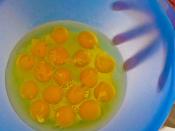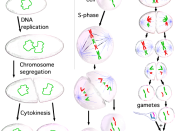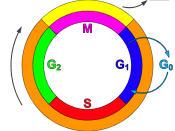Mitosis is the process in which a cell's nucleus replicates and divides in preparation for division of the cell. Mitosis results in two cells that are genetically identical. Mitosis is necessary for growth for repair and replacement of damaged or worn out cells.
All multi-cellular animals; plants, fungi, and protists, which begin life as single cells, carry out mitosis to develop into complex organisms containing billions of cells. Mitosis occurs in fully-grown organisms by maintaining it: replacing dying skin cells, for example or repairing damaged muscle cells. In the cells of the adult human body, mitosis occurs about 25 million times a second. Multi-cellular organisms such as sea stars, sea anemones, fungi, and certain plants rely on mitosis for asexual reproduction at particular stages in their life cycles, and mitosis is the sole method of reproduction for many single-celled organisms.
The life cycle of eukaryotic cells, or cells containing a nucleus, is a continuous process typically divided into three phases for ease of understanding: interphase, mitosis, and cytokinesis.
Interphase includes three stages, referred to as G1, S and G2. In G1, a newly formed cell synthesizes materials needed for cell growth. In the S stage, deoxyribonucleic acid (DNA), the genetic material of the cell, is replicated. At this stage, DNA consists of long, thin strands called chromatin. As each strand is replicated, it is linked to its duplicate by a structure known as a centromere. When the S stage is complete, the cell enters a brief stage known as G2, when specialized enzymes correct any errors in the newly synthesized DNA, and proteins involved with the next phase, mitosis, are synthesized.
Mitosis occurs in four steps. In prophase, the replicated, linked DNA strands slowly wrap around proteins that in turn coil and condense into two short, thick, rod like...


